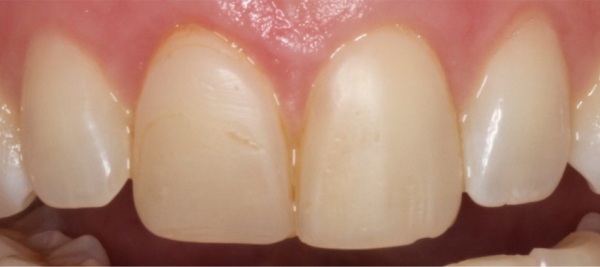Hello Dr. Hall, 9 months ago I had dental bonding done on my four front teeth. There is quite a bit of composite on each tooth because I have been re-doing it every 3 or 4 years for 20 years. My question to you is, I see a bit of yellowing, is it possible to just polish them to try and whiten them again since they were done just 9 months ago? Thank you for your time!
– Linda from New Jersey
We thank our advertisers who help fund this site.
Linda,
One of the big differences between composite bonding and porcelain veneers is that the porcelain is very hard and stain-resistant (it resists stains better than tooth enamel), and composite is much softer and much more susceptible to stains, so it has a much shorter lifespan.
The good news is that with the composite bonding, usually those stains can be polished out, depending on the type of stains.
Composite is susceptible to two types of staining. The first type, the type that can be polished away, is a surface discoloration. The surface of the composite will get tiny scratches in it and become roughened which causes it to attract stains of all kinds. A good polishing will get rid of the scratches and the accompanying stain and restore gloss to the surface. Below is an example of this type of staining. You can see that the surface of the two front teeth has a matte finish from all the tiny scratches, as contrasted with the gloss of the adjacent natural teeth:

Photo courtesy of Dr. Robert Soto, San Francisco, CA
But composite will also absorb stains into the actual substance of the material. Composite is composed of inorganic filler particles such as quartz or glass bound together in a plastic matrix. Certain colored liquids, such as coffee, tea, cola drinks, or highly pigmented fruit juices, will actually penetrate the plastic part of the material and become a part of it.

Photo courtesy of Dr. Mark W. Langberg, Southfield, MI
This type of stain will not come out with polishing. But this staining also occurs more slowly and can take a couple of years to become noticeable. At the right is an example of this type of staining. You can see that the composite has retained its gloss. The discoloration is coming from deep within, as stains have been absorbed by the material.
Preventing This Staining
There are several preventive measures you can take to get the bonding to keep its nice appearance for longer.
1. First, choose an expert cosmetic dentist who stocks a full inventory of esthetic bonding materials. General dentists will typically stock general purpose composites that are actually impossible to polish to the high gloss needed to resist stain and look like enamel. The surface of the bonding should be a microfill composite that is polished to a high shine.
2. Second, don’t use an abrasive toothpaste. While Supersmile toothpaste is quite a bit more expensive than your typical Crest, Colgate, or other drugstore brand, those general brands have abrasives in them that will scratch the surface of your bonding. Some of the abrasives are worse than others. I always provided my bonding patients with a first free tube of Supersmile, because it has no abrasives but rather lifts stains off by chemically dissolving the protein pellicle on the teeth.
3. Third, make sure your dental hygienist is polishing your teeth with a very fine abrasive. Pumice tooth polish is a big no-no. She or he should be using a fine aluminum oxide polish. Ask for this. (See my web page giving tips for maintenance of dental bonding.)
3. Fourth, beware of staining beverages. If you need to drink them, swallow them quickly rather than letting them sit in your mouth. And remember that hot beverages have more staining power than cold ones because they cause a slight expansion of the plastic, opening up microscopic pores that can be penetrated with the stain.
Finally, I would seriously consider switching to porcelain veneers. I don’t know how much your dentist is charging for this bonding, but dentists who do it well will charge quite a bit. Which costs more–doing composite bonding six times over 20 years, or doing porcelain veneers once for those same 20 years? Porcelain veneers done by an expert cosmetic dentist can easily look beautiful for 20 years. Porcelain is harder than tooth enamel and more stain-resistant. But go to an expert cosmetic dentist for porcelain veneers–don’t ask your family dentist to do this.
– Dr. Hall
Do you have a comment or a question or anything else to add? We’d love to hear from you. Enter your comment below.
Click here to ask Dr. Hall a question of your own.
About David A. Hall
Dr. David A. Hall was one of the first 40 accredited cosmetic dentists in the world. He practiced cosmetic dentistry in Iowa, and in 1990 earned his accreditation with the American Academy of Cosmetic Dentistry. He is now president of Infinity Dental Web, a company in Mesa, Arizona that does advanced internet marketing for dentists.
